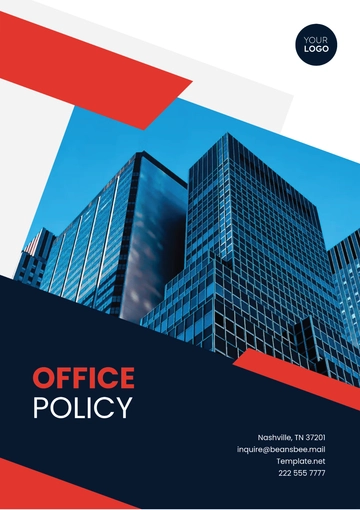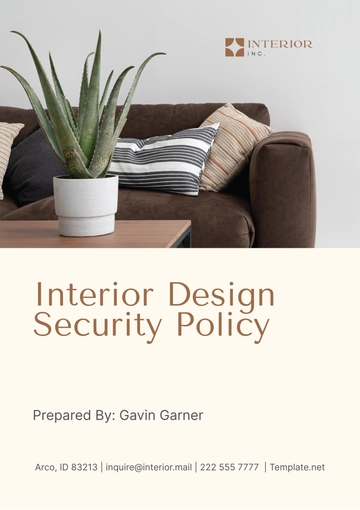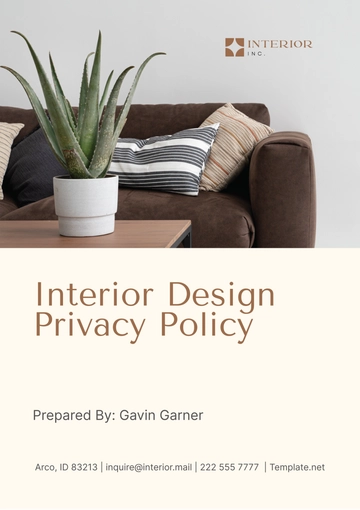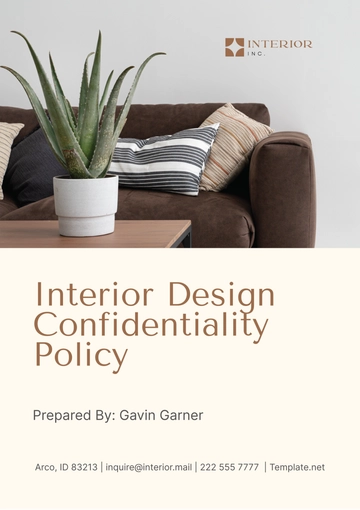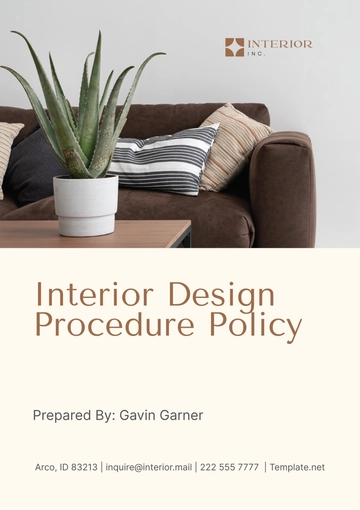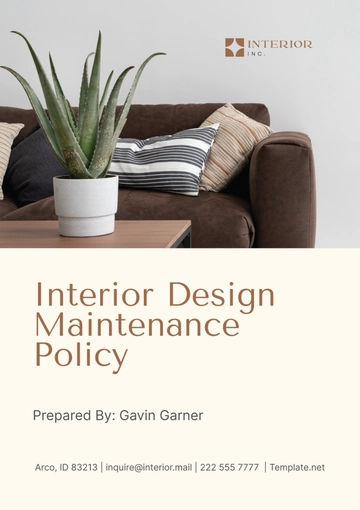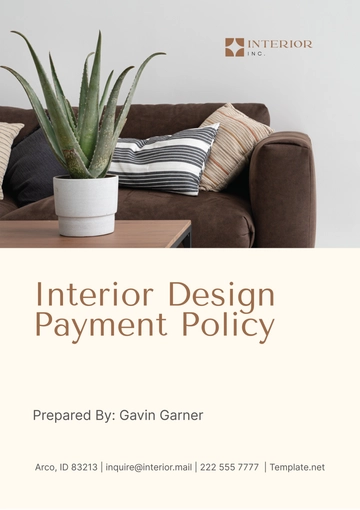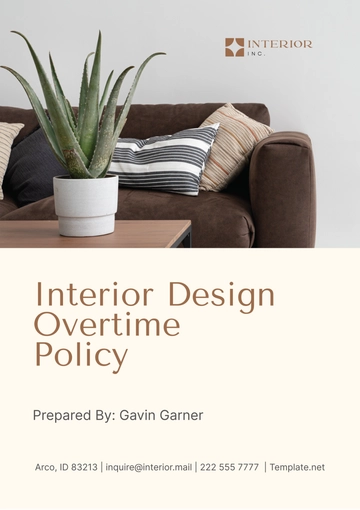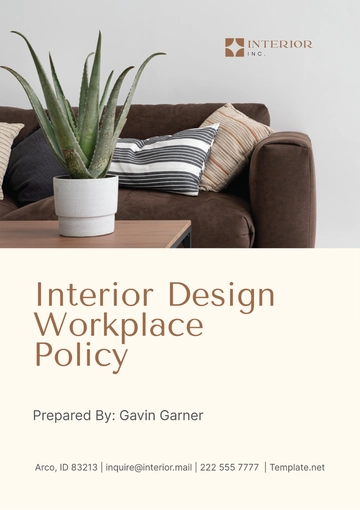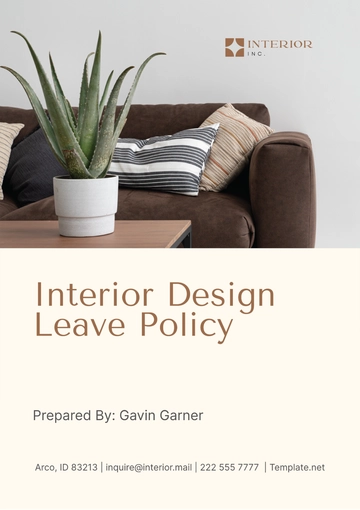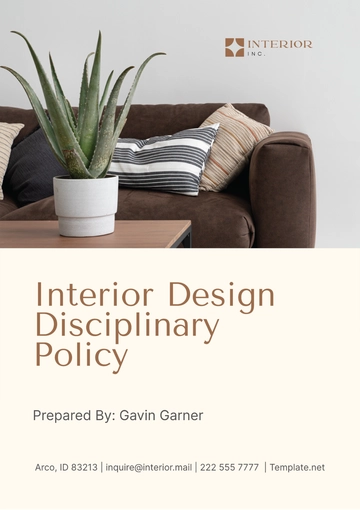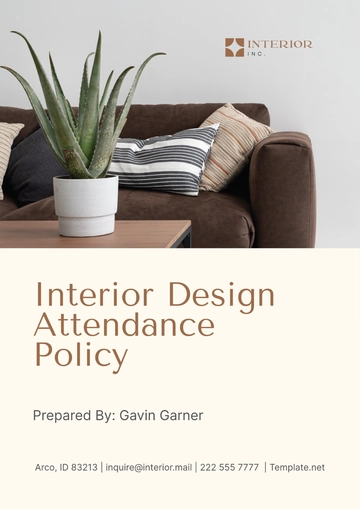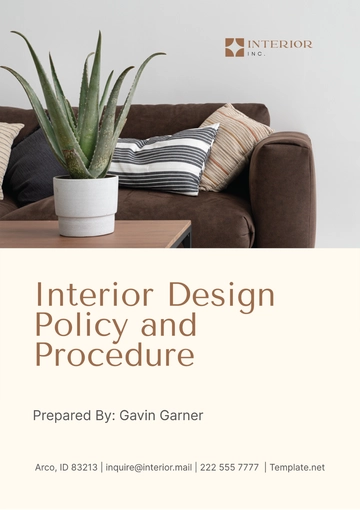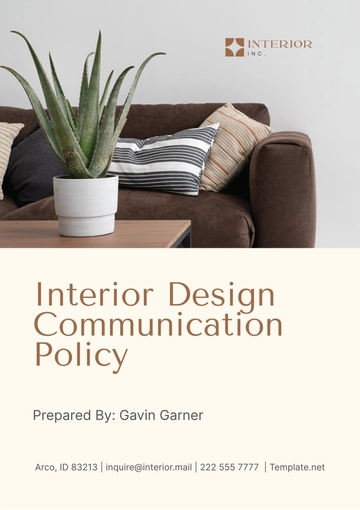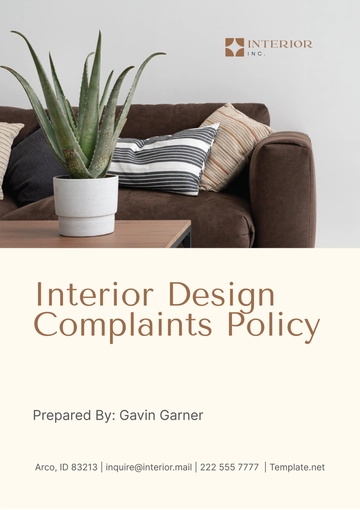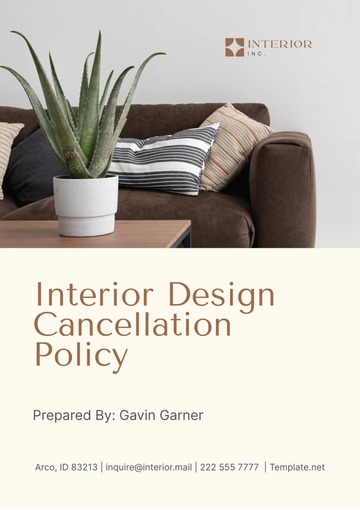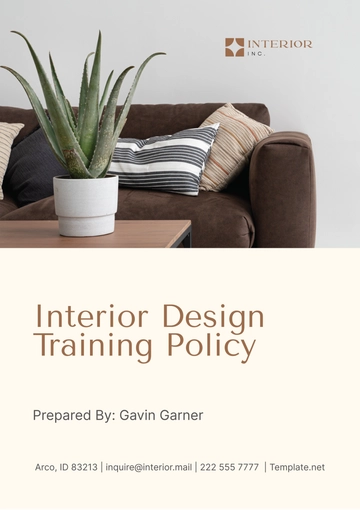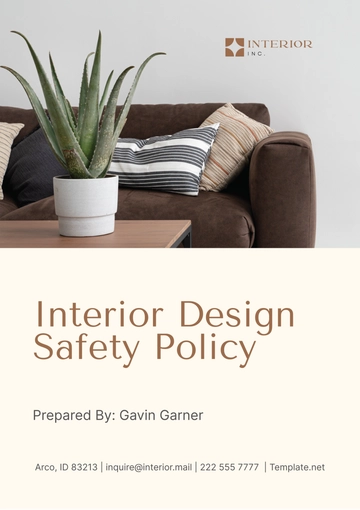Free Interior Design Safety Policy
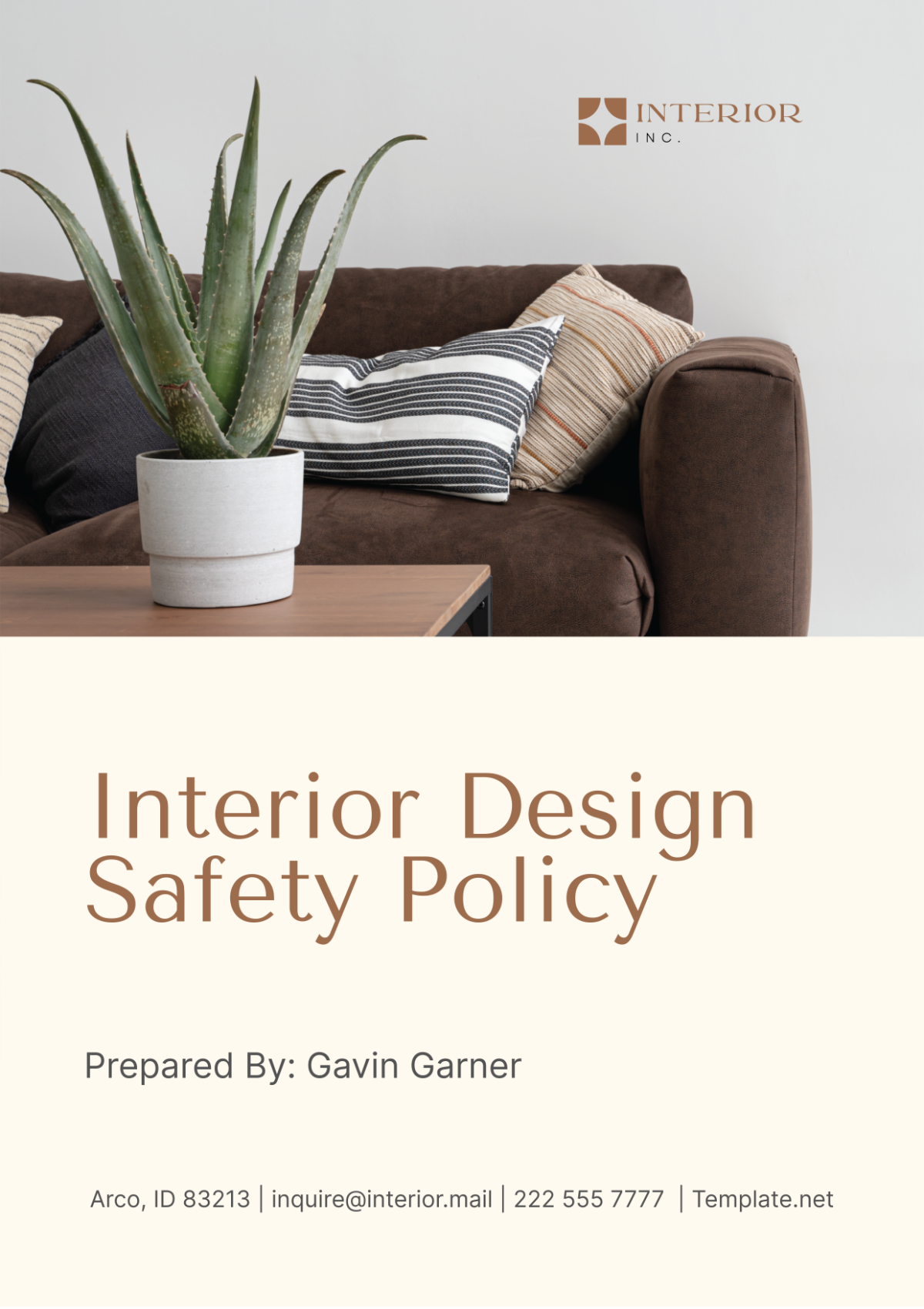
I. Introduction
A. Purpose
The purpose of this Interior Design Safety Policy is to establish guidelines and procedures to ensure the safety of employees, contractors, visitors, and clients within [Your Company Name] premises and projects. This policy aims to promote a culture of safety and minimize the risk of accidents, injuries, and occupational hazards in all interior design activities undertaken by [Your Company Name].
B. Objectives
The objectives of this policy include:
Providing a safe and healthy work environment for all individuals involved in interior design projects.
Complying with relevant safety regulations, codes, and standards.
Identifying and mitigating hazards associated with interior design activities.
Ensuring that employees, contractors, visitors, and clients are aware of their responsibilities regarding safety.
Establishing procedures for incident reporting, investigation, and corrective action.
Promoting continuous improvement in safety performance through training, evaluation, and feedback mechanisms.
C. Applicability
This policy applies to all employees, contractors, visitors, and clients of [Your Company Name] involved in interior design projects, including but not limited to:
Interior design consultants
Architects and designers
Project managers
Contractors and subcontractors
Suppliers and vendors
Clients and stakeholders
II. Responsibilities
A. Management Responsibilities
Senior management at [Your Company Name] is responsible for:
Establishing safety policies and procedures consistent with legal requirements and industry best practices.
Providing adequate resources, including personnel, training, and equipment, to support safety initiatives.
Designating competent individuals to oversee safety management and enforcement.
Monitoring compliance with safety regulations and standards through regular audits and inspections.
Communicating safety objectives, expectations, and performance metrics to all employees and stakeholders.
Reviewing and evaluating the effectiveness of safety policies and procedures on an ongoing basis.
B. Employee Responsibilities
All employees of [Your Company Name] have a responsibility to:
Follow safety policies, procedures, and instructions provided by management.
Participate in safety training programs and adhere to safe work practices.
Report any safety hazards, incidents, or near misses promptly to their supervisor or designated safety officer.
Use personal protective equipment (PPE) and safety devices as required for their tasks.
Take reasonable care to protect their own health and safety, as well as that of their colleagues and others affected by their work.
Cooperate with management and safety representatives in implementing safety measures and initiatives.
C. Contractor and Visitor Responsibilities
Contractors and visitors engaged in interior design projects at [Your Company Name] premises or worksites are required to:
Comply with [Your Company Name] safety policies, procedures, and site rules.
Attend safety induction and orientation sessions before commencing work on-site.
Inform [Your Company Name] personnel of any safety concerns or hazards they encounter during their visit or work activities.
Take appropriate precautions to safeguard their own health and safety, as well as that of others in the vicinity.
Follow emergency procedures and evacuation protocols in the event of an incident or emergency situation.
III. Hazard Identification and Risk Assessment
A. Hazard Identification
[Your Company Name] conducts regular assessments to identify potential hazards in interior design projects, including but not limited to:
Hazard Category | Examples |
|---|---|
Electrical Hazards | Faulty wiring, exposed outlets, overloaded circuits |
Trip and Fall Hazards | Loose cables, uneven flooring, cluttered work areas |
Chemical Hazards | Paints, adhesives, solvents, cleaning chemicals |
Ergonomic Hazards | Poorly designed workstations, improper lifting techniques |
B. Risk Assessment
Once hazards are identified, [Your Company Name] conducts risk assessments to evaluate the severity and likelihood of potential accidents or injuries. Risk control measures are implemented to mitigate identified risks, including:
Risk Control Measures | Implementation Steps |
|---|---|
Engineering Controls | Redesigning workstations, installing safety barriers |
Administrative Controls | Establishing safe work procedures, providing training |
Personal Protective Equipment (PPE) | Providing appropriate PPE such as gloves, goggles, and safety footwear |
Hazard Elimination | Removing or replacing hazardous materials or equipment |
IV. Safety Procedures
A. Electrical Safety
All electrical installations and equipment used in interior design projects must comply with relevant electrical safety standards and regulations. Specific safety procedures include:
Electrical Safety Procedures | Description |
|---|---|
Regular Inspection and Maintenance | Scheduled inspections of electrical systems and equipment to identify and address potential hazards |
Lockout/Tagout Procedures | Locking out energy sources before performing maintenance or repair work |
Ground Fault Circuit Interrupters (GFCIs) | Installing GFCIs to prevent electrical shocks in wet or damp locations |
Electrical Safety Training | Providing training on safe electrical practices and procedures for employees and contractors |
B. Fire Safety
Fire safety procedures are essential to prevent fires and ensure prompt evacuation in the event of an emergency. Key measures include:
Fire Safety Procedures | Description |
|---|---|
Fire Extinguisher Training | Training employees on the proper use of fire extinguishers and firefighting equipment |
Emergency Evacuation Drills | Conducting regular evacuation drills to familiarize occupants with escape routes and procedures |
Smoke Detection and Alarm Systems | Installing and maintaining smoke detectors and fire alarm systems for early detection of fires |
Fire Extinguisher Inspection and Maintenance | Regular inspection and maintenance of fire extinguishers to ensure they are functional and accessible |
C. Chemical Safety
Hazardous chemicals used in interior design projects pose risks to health and safety if not handled properly. Safety procedures for chemical handling include:
Chemical Safety Procedures | Description |
|---|---|
Material Safety Data Sheets (MSDS) | Providing access to MSDS for all hazardous chemicals used on-site |
Chemical Storage and Labeling | Storing chemicals in designated areas with proper ventilation and labeling containers with hazard information |
Personal Protective Equipment (PPE) | Providing appropriate PPE such as gloves, goggles, and respirators for handling hazardous chemicals |
Spill Response and Cleanup | Establishing procedures for containing and cleaning up chemical spills to minimize exposure and environmental impact |
D. Ergonomic Safety
Ergonomic safety is essential to prevent musculoskeletal disorders and promote comfort and productivity. Ergonomic procedures include:
Ergonomic Safety Procedures | Description |
|---|---|
Workspace Design | Designing workstations with adjustable furniture and equipment to accommodate different users |
Ergonomic Training | Providing training on proper posture, lifting techniques, and workstation setup |
Breaks and Stretching Exercises | Encouraging employees to take regular breaks and perform stretching exercises to reduce fatigue and strain |
Ergonomic Assessments | Conducting ergonomic assessments of workstations to identify and address ergonomic risk factors |
V. Incident Reporting and Investigation
A. Reporting Procedures
All accidents, injuries, near misses, and safety hazards must be reported to management immediately using the designated reporting channels, which may include:
Reporting Channels | Description |
|---|---|
Supervisor or Manager | Employees should report incidents to their immediate supervisor or manager |
Safety Officer or Representative | Alternatively, incidents can be reported to the designated safety officer or representative |
Incident Reporting Form | Employees may use an incident reporting form to document details of the incident and submit it to management |
It is essential to report incidents promptly to ensure timely investigation and corrective action to prevent recurrence.
B. Investigation Process
[Your Company Name] conducts thorough investigations of all reported incidents to determine root causes and prevent recurrence. The investigation process includes:
Investigation Steps | Description |
|---|---|
Immediate Response | Management responds promptly to reported incidents to ensure the safety of personnel and mitigate immediate hazards |
Gathering Information | Investigating personnel gather relevant information, including witness statements, photographs, and physical evidence |
Root Cause Analysis | Conducting a systematic analysis to identify underlying causes and contributing factors of the incident |
Corrective Action Plan | Developing a corrective action plan to address identified root causes and prevent recurrence |
Documentation | Documenting investigation findings, corrective actions taken, and recommendations for future prevention |
Corrective actions are implemented based on investigation findings to address underlying safety issues and improve safety performance.
VI. Training and Education
A. General Safety Training
All employees must receive comprehensive safety training upon hire and refresher training annually. General safety training topics include:
General Safety Training Topics | Description |
|---|---|
Hazard Recognition and Control | Identifying common workplace hazards and methods to control or mitigate them |
Emergency Procedures | Responding to emergencies such as fires, medical emergencies, and evacuation procedures |
Personal Protective Equipment (PPE) | Proper selection, use, and maintenance of PPE for various tasks and hazards |
Workplace Ergonomics | Ergonomic principles and practices to prevent musculoskeletal injuries |
Training sessions may be conducted through in-person sessions, online modules, or a combination of both, depending on the availability and preferences of employees.
B. Job-specific Training
Employees involved in interior design projects receive job-specific safety training relevant to their roles and tasks. Job-specific training topics may include:
Job-specific Training Topics | Description |
|---|---|
Electrical Safety Procedures | Safe handling of electrical equipment and installations, including lockout/tagout procedures |
Chemical Handling and Storage | Proper storage, handling, and disposal of hazardous chemicals used in interior design |
Fire Safety Procedures | Response to fires and proper use of firefighting equipment such as fire extinguishers |
Ergonomic Work Practices | Proper workstation setup and techniques to prevent ergonomic injuries |
Training sessions are tailored to address specific hazards and risks associated with interior design activities and are provided to employees before commencing work on relevant projects.
VII. Safety Performance Evaluation
A. Metrics and Indicators
[Your Company Name] monitors safety performance using key metrics and indicators to assess the effectiveness of safety policies and procedures. Key metrics include:
Safety Performance Metrics | Description |
|---|---|
Number of Incidents | Total number of accidents, injuries, and near misses reported within a specific period |
Lost Time Injury Frequency Rate (LTIFR) | Number of lost time injuries per 1 million hours worked, calculated over a designated timeframe |
Near Miss Reports | Number of near miss incidents reported, indicating potential hazards or safety deficiencies |
Safety Training Participation Rates | Percentage of employees who have completed required safety training within a given timeframe |
These metrics provide insights into the overall safety performance of [Your Company Name] and help identify areas for improvement.
B. Continuous Improvement
Safety performance data is analyzed regularly to identify trends, areas for improvement, and opportunities for preventative action. Continuous improvement initiatives include:
Continuous Improvement Initiatives | Description |
|---|---|
Safety Committee Meetings | Regular meetings of a safety committee to review incident reports, discuss safety concerns, and develop improvement plans |
Safety Culture Surveys | Conducting surveys to assess the safety culture within the organization and identify areas for enhancement |
Hazard Correction and Prevention | Implementing corrective actions to address identified hazards and prevent future incidents |
Safety Recognition Programs | Recognizing and rewarding employees for their contributions to safety and promoting a positive safety culture |
[Your Company Name] is committed to ongoing improvement in safety performance through proactive measures and employee engagement.
VIII. Compliance and Enforcement
A. Regulatory Compliance
[Your Company Name] complies with all applicable safety regulations, codes, and standards relevant to interior design activities. Compliance measures include:
Compliance Measures | Description |
|---|---|
Regulatory Audits and Inspections | Conducting regular audits and inspections to ensure compliance with safety regulations |
Compliance Training | Providing training to employees on relevant safety regulations and standards |
Documentation and Record Keeping | Maintaining records of regulatory compliance, including permits, licenses, and inspection reports |
[Your Company Name] is committed to upholding high standards of safety and regulatory compliance in all interior design projects.
B. Enforcement
Non-compliance with safety policies and procedures may result in disciplinary action, up to and including termination of employment. Enforcement measures include:
Enforcement Actions | Description |
|---|---|
Progressive Discipline | Implementing a progressive disciplinary process for repeated safety violations, including verbal warnings, written warnings, and suspension |
Safety Performance Reviews | Including safety performance as a criterion in employee performance evaluations |
Employee Training and Education | Providing additional training and education to address knowledge gaps or deficiencies in safety compliance |
[Your Company Name] takes a proactive approach to enforcement to ensure accountability and promote a culture of safety among all employees and contractors.
XI. Review and Revision
A. Regular Review
This Interior Design Safety Policy undergoes periodic review to ensure its alignment with current safety regulations, industry standards, and best practices. Reviews are conducted annually or as needed in response to significant changes in operations, technology, or regulatory requirements.
B. Revision Process
Proposed revisions to the safety policy are subject to thorough review by management and relevant stakeholders.
The revision process involves:
Revision Steps | Description |
|---|---|
Identification of Needs | Identifying the need for revisions based on changes in regulations, incidents, or feedback from stakeholders |
Drafting Revisions | Developing draft revisions to address identified needs, incorporating input from subject matter experts and stakeholders |
Review and Approval | Reviewing and approving draft revisions by senior management or a designated review committee |
Communication and Training | Communicating revised policies and procedures to all relevant parties and providing training as necessary |
Implementation | Implementing revised policies and procedures throughout the organization, ensuring understanding and compliance by employees |
Revisions are communicated to all relevant parties and incorporated into training and procedures as necessary to ensure awareness and adherence.
C. Conclusion
[Your Company Name] is committed to maintaining an up-to-date Interior Design Safety Policy to protect the well-being of employees, contractors, visitors, and clients. Through regular review and revision, we strive to continuously improve safety standards and practices in all interior design activities.
For any questions or feedback regarding this policy or its revision process, please contact [Your Name], [Your Position], at [Your Company Email] or [Your Company Number].
- 100% Customizable, free editor
- Access 1 Million+ Templates, photo’s & graphics
- Download or share as a template
- Click and replace photos, graphics, text, backgrounds
- Resize, crop, AI write & more
- Access advanced editor
Prioritize safety in your interior design projects with Template.net's Interior Design Safety Policy Template. This customizable document offers a comprehensive framework for establishing safety protocols and procedures to protect employees, clients, and contractors in the interior design environment. Enhance compliance with regulations and minimize risks. Editable in our Ai Editor Tool for seamless customization to align with your interior design safety standards and requirements.
You may also like
- HR Policy
- Restaurant Policy
- Company Policy
- Accounting Policies and Procedures
- Website Policy
- Privacy Policy
- Safety Policy
- School Policy
- IT and Software Policy
- Law Firm Policy
- Construction Policy
- Interior Design Policy
- Travel Agency Policy
- Education Academic Policy
- Security Policy
- Real Estate Policy
- Expense Policy
- Software Policy
